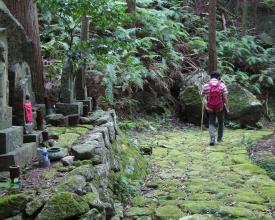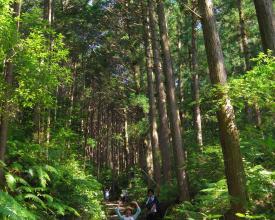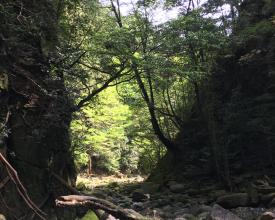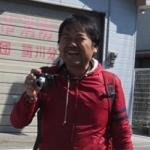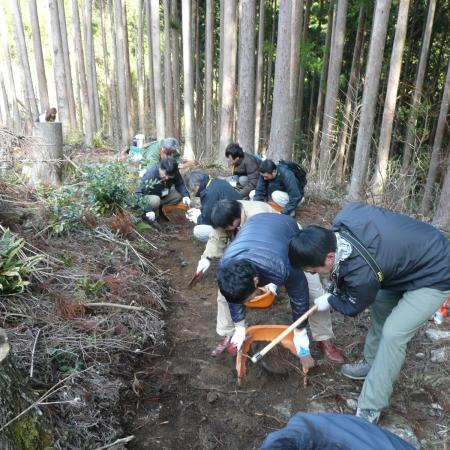
Integrating religious and traditional stewardship in the management of the Sacred Sites and Pilgrimage Routes in the Kii Mountain Range World Heritage, Japan
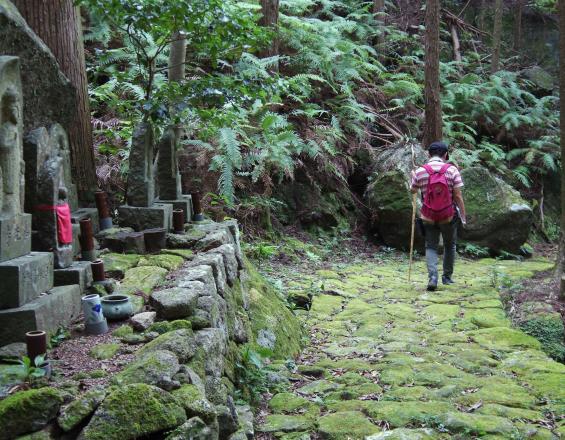
The Sacred Sites and Pilgrimage Routes of the Kii Mountain Range in Japan were inscribed as a cultural landscape in the World Heritage List in 2004, under criteria (ii), (iii), (iv) and (vi). The inscribed property includes parts of the Yoshino-Kumano National Park, IUCN Protected Area Category II and core of the Mount Odaigahara, Mount Omine and Osugidani UNESCO Biosphere Reserve, and places of scenic beauty, historic sites, national treasures and natural monuments which are protected under the Japanese Law for the Protection of Cultural Property. It is composed of the cores of three of the most significant religions in Japan: Shintoism in Kumano-Sanzan, Shingon Buddhism in Koyasan and Shugendo in Yoshino and Omine, and the pilgrimage routes connecting them. The management of such a complex property where natural and cultural values and protection systems interrelate relies on its sacred value and the continuous stewardship of the religious and local communities present in the area.
Context
Challenges addressed
The conservation of the Kii Mountains’ cultural landscape presents a management challenge due to the complexity of the property: Being located across three adjacent prefectures and containing several layers of protection for the diverse natural and cultural resources, it requires the coordination of a variety of stakeholders.
This property contains 3 sacred mountains representative of the 3 major religions of Japan. The coordination of the different religion bodies is a key challenge.
Each of the religious bodies are in charge of primary forests and other forests within their area. These need to be maintained and managed on an ongoing basis. The maintenance of the secondary forests surrounding primary forests, religious sanctuaries and pilgrimage routes is equally important.
The pilgrimage routes which are not under the control of these religious groups, can quickly become overgrown with weeds and fallen trees if left unattended, making them inaccessible for pilgrims and tourists.
Location
Process
Summary of the process
The establishment of a transboundary governing structure for the World Heritage Property (BB1) enabled the cooperation between the different religious bodies, which remain autonomous in the management of their sacred places (BB2). The forests and temples in charge of the religious bodies are connected by the pilgrimage routes, that are both conserved by the government and by the local communities, because there is a large variability on their ownership. The maintenance of all these natural and cultural elements of the property is based on their spiritual value, not only for the religious institutions in charge, but also for the local communities inhabiting these areas. Both the tradition of maintaining the pilgrimage routes (BB4) and the community-based conservation of the secondary forests (BB3) connect with the Japanese cultural traditional of stewardship of nature.
Building Blocks
Transboundary governing structure for the World Heritage Property
Besides containing cultural heritage designated under the Law for the Protection of Cultural Property enforced by the Agency for Cultural Affairs, the property contains areas that conform the Yoshino-Kumano National Park which administration is in charge of the Ministry of the Environment and the three prefectures that are related to it: Wakayama, Nara and Mie, and their local authorities. The Three Prefectures’ Council for the World Heritage Sacred Sites and Pilgrimage Routes in the Kii Mountain Range, was first established to pursue the nomination to the World Heritage List, and after the inscription, it is in charge of coordinating conservation actions and developing the management plan. The governors of the three prefectures serve as chairpersons and vice chairpersons, while the mayors and heads of education of the municipalities serve as members of the council. The Agency for Cultural Affairs participates as an observer. The protection of cultural properties is carried out in cooperation with the department of cultural property protection and regional development of each prefecture and the person in charge of the municipality. In addition, the Council is advised by a scientific committee consisting of experts from several fields.
Enabling factors
The strong interest of the three prefectures and the government in inscribing the Kii Mountains cultural landscape in the World Heritage List enabled the establishment of a partnership between the prefectures and the governmental institutions in charge of conservation in order to develop and pursue the nomination.
Lesson learned
In accordance to the recommendations of the World Heritage Committee at the time of the inscription, the three prefectures formulated a comprehensive conservation management plan and established a system in which the three prefectural councils take the lead in conservation and management. This system had a major impact on the way in which several prefectures in Japan nominated other sites for inscription on the World Heritage List and managed its conservation such as Fujisan, sacred place and source of artistic inspiration (Mount Fuji).
Granting autonomy to religious bodies in the management of their sacred places (forests and temples)
Through the whole process that the sacred places in the Kii Mountains were being designated as cultural heritage and natural heritage (as part of a national park), and later included in the Biosphere Reserve, to finally be part of the World Heritage property, the religious bodies were officially granted their protection and management following the traditional knowledge carried for centuries, based on religious beliefs and sacred values. For instance, due to their sacred character, primeval forests have been conserved under strict felling prohibitions by the different religious communities. The mountain landscapes are interpreted as materialized “mandalas” by Shingon Buddhists, and Shugendo practitioners reproduce “mandalas” by doing pilgrimage and performing their ascetic practices in these natural environments. For pilgrims, the Kii Mountains represent the paradise on earth. Another example is the Nachi sacred forest that has been designated as a “Natural monument” under the Law for the Protection of Cultural Property, and the management has been done by the Kumano Nachi Shinto shrine, as part of their sacred place. The Nachi waterfall is regarded as sacred. This means that the sacred waters cannot be touched or diverted.
Enabling factors
- Persistent cultural practices, traditional and local knowledge based on the belief of sacredness of nature.
- Legal protection under the Law for the Protection of Cultural Property and the Natural Parks Law are designed to relegate and uphold the traditional nature-human relationship without imposing frameworks that are inconsistent with religious-based protection.
Lesson learned
- Sacredness has protected the Kii Mountains primeval forests for more than 1,000 years and continuing. Enabling religious stewardship to continue practicing their traditions of forest conservation facilitates the conservation process.
- Importance of the safeguarding of traditional knowledge and the spiritual values of local people to continuously protect the primeval forests.
Continuation of the traditional community-based conservation of secondary forests
Most of the forested areas of the Kii mountains have been planted because this area has traditionally been a place for logging. Trees are cut down every 50 to 100 years, and after the logging, people plant small trees. This traditional logging strategy has been done since the 16th century under a traditional technique such as seed collection, planting, planting density, thinning and felling especially in the Yoshino County, Nara Prefecture, where cherries are characteristic. Nara Prefecture has also introduced a tax for the conservation of the forest environment and is working with volunteers and private organizations through its municipalities to cut down abandoned forests. The abandoned forests have been replanted with broad-leaved trees instead of coniferous trees such as cedar and cypress, which are suitable for forestry, and mixed forests of coniferous and broad-leaved trees are being converted to forests that are free of human intervention in the future. In parallel with traditional tree-planting and harvesting, we are trying to maintain the forests and forest landscape in the Kii Mountains in a sustainable manner.
Enabling factors
- Traditional logging performed in the area for centuries and continuity of this tradition
- Support from the government and other relevant authorities to continue with this tradition
Lesson learned
- In recent years, the number of forestry workers has been decreasing due to a reduction in the demand for timber, a rise in cost and a lack of successors. The number of abandoned forests has been increasing, which has been the main reason for the control of planting density. This has resulted in changes to the forest ecology, soil erosion due to poor undergrowth, favoring landslides, floods, droughts and other hazards provoking disasters.
- The recent promotion of renewable energy has led to the construction of solar and wind power facilities. This has led to large-scale deforestation, and there are concerns that this may affect the preservation of the World Heritage site. It is necessary to establish a system for collecting information on the construction of these facilities and coordinating in advance, such as the preparation of guidelines, in order to ensure coexistence with the World Heritage.
Participatory conservation of pilgrimage paths
Depending on their location, pilgrimage routes are owned by individuals, local or national governments who take care of their maintenance. Local inhabitants and Non-Profit Organizations (NPO) participate as well of the restoration, conservation and maintenance of some of the pilgrimage routes. For example, many preservation societies are active on the Iseji pilgrimage route where they conduct daily cleaning activities on the mountain passes where old roads remain. They also collaborate with patrolling after typhoons and heavy rains. These activities are recorded in the report and submitted to the respective Prefectural Board of Education via the respective Municipal Board of Education.
Enabling factors
- Japanese culture emphasizes on the caring for the public space and the benefit of the community as a whole, as well as supports a strong identification with and caring for the environment.
- Support from the government and other agencies to facilitate citizen participation in volunteering activities, such as collection and distribution of donations.
Lesson learned
- The government will cooperate with citizens who initiate volunteer activities.
- In the World Heritage property, some of the activities need a permission. This is something that needs to be confirmed in advance by the volunteers and the government.
Impacts
1. Environmental impacts:
- Effective and continuous conservation of primeval forests. For example, the Nachi Primeval Forest is one of the most representative laurel forest of this region, covering an area of 32 hectares. It is a valuable forest not only because of the dense layer of tall trees such as Japanese cypress (hinoki-Chamaecyparis obtusa), Japanese chinquapin (tsuburaji-Castanopsis cuspidata), and Japanese oak blue (urajirogashi- Arhopala japonica or Quercus salicina), but also because of the abundance of forest floor plants such as ferns and vines. Another example is the Bukkyogatake Primeval Forest, one of the highest peak of the Omine Mountains, covering an area of 9 hectares, which is composed of evergreen coniferous trees such as Veitch forest of subalpine origin.
2. Economical and environmental impacts:
- Sustainable use of secondary forests
- Sustainable tourism development
3. Social impacts:
- Community cohesion
- Traditional knowledge safeguarded
- Local and traditional cultural and religious practices safeguarded
Beneficiaries
Local communities, worshipers of each religion, pilgrims, visitors
Sustainable Development Goals
Story

As a prefectural officer, I am involved in the preservation of this World Heritage site. One of the most unforgettable moments in my career is the disaster of the 2011 typhoon.
On September 4, a typhoon struck the area: Railroads were destroyed, national roads were cut off, and landslides occurred in many parts of the Kii Mountains. Particularly serious was the damage to the pilgrimage routes.
On September 7, we received a phone call from a city officer. He reported damage to the World Heritage site. Amid the disaster, they were still making rounds to assess the damage. Local volunteers were making rounds of the pilgrimage route. Together, they sent the information to the prefectural government office, located 100 kms. away.
On September 8, the national road was opened to traffic. I drove to the World Heritage site. Volunteers had begun to clean up the pilgrimage route and remove fallen trees.
Also washed away was a huge tree that was the symbol of the holy island in the river. The owner, the shrine's priest, offered to restore it by planting trees.
There was also damage to the secondary forests surrounding the pilgrimage route belonging to the buffer zone of the World Heritage property, and which are maintained by owners and the forest association. They offered to remove the fallen trees and plant saplings.
In the meantime, I was able to negotiate with the national government to provide funding for the restoration plan of the large affected areas.
After a while, the city hall officer who first called me, said to me "I'd love to study the concept of World Heritage. I would like to be able to do a better job of protecting the World Heritage site.” I spoke to the colleagues with whom we were discussing the restoration of the site, and we decided to hold a workshop to bring together people from the three prefectures, the municipal and the national government. These workshops continue after 10 years.
The "Sacred Sites and Pilgrimage Routes in the Kii Mountain Range" are protected by the efforts of many different people: the three prefectures, municipalities, volunteers, religious leaders, and foresters. Protection is achieved through dialogue, mutual learning and cooperation between the parties. We should not forget the efforts of all those people. (Fumihiko Ito, Mie Prefecture)

